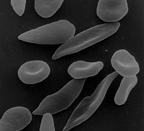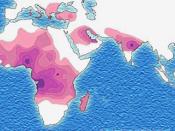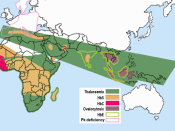Description- Sickle-cell anemia is a heredity blood disease. Those who have sickle-cell anemia have red blood cells containing an abnormal type of hemoglobin called Hemoglobin S. A normal person's red blood cells have Hemoglobin A, and are round and soft which makes it easy for them to pass through the small blood vessels. The lifespan of a normal blood cell is approximately 120 days. But those with sickle-cell anemia lack normal hemoglobin, and their lifespan is only 16 days. Hemoglobin is the substance that makes blood red and that carries oxygen to the body tissues. In this case the amount of oxygen, in the blood, is reduced for no reason. Sickle hemoglobin forms a type of crystal in the red blood cell. When the cell loses oxygen as it goes through capillaries, the crystal then causes the normal round red blood cells to change into slender, twisted, rigid sickle forms.
Sickle cells stick together and get trapped in the capillaries and block the normal flow of blood through them. When sickle-shaped cells plug up small blood vessels, lesser blood reaches various parts of the body. This damages the tissue, which does not receive normal blood flow. This is what causes the complications of sickle cell disease.
Dominant? Recessive? - Sickle cell is recessive. In order for a newborn to posses this trait they have to receive one sickle hemoglobin, gene, from each parent. If the child gets only one copy of the gene form one parent then the child has sickle-cell trait but do not have the disease.
Chromosome- Sickle-cell anemia is located on chromosome 11.
What Ethnicity? - In the United States sickle cell occurs highly in African Americans. It also affects other groups, including Hispanics, Middle Eastern, and Mediterranean ancestry. It also occurs among the people of...


